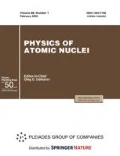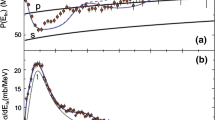Abstract
Experimental studies of neutron drip line nuclei are introduced. The neutron drip line in the oxygen-magnesium region has been explored by the projectile fragmentation of a 48Ca beam. New neutron-rich isotopes, 34Ne and 37Na, have been observed together with some evidence for the particle instability of 33Ne and 36Na. Recent data on mass measurements of neutron-rich nuclei at GANIL and some characteristics of binding energies in this region are discussed. Nuclear binding energies are very sensitive to the existence of nuclear shells, and together with the measurements of instability of doubly magic nuclide 28O, they provide information on changes in neutron shell closures of very neutron-rich isotopes from carbon up to calcium. The conclusion about a rearrangement in neutron shell closures is given. The spectroscopic measurements can reveal details of the underlying microscopic structures; in-beam γ-ray spectroscopy is an effective tool to check for shell closures. The results on the γ-ray energies of the first 2+ level in even-even nuclei for the range N=12–32 are discussed. The strength of N=20 and N=28 shells is variable in the region from carbon up to magnesium.
Similar content being viewed by others
References
C. Thibault et al., Phys. Rev. C 12, 644 (1975).
S. Lukyanov et al., J. Phys. G 28, L41 (2002).
M. Notani et al., Phys. Lett. B 542, 49 (2002).
D. Guillemaud-Mueller et al., Z. Phys. A 332, 189 (1989).
O. B. Tarasov et al., Phys. Lett. B 409, 64 (1997).
M. Fauerbach et al., Phys. Rev. C 53, 47 (1996).
H. Sakurai et al., Phys. Rev. C 54, R2802 (1996).
H. Sakurai et al., Phys. Lett. B 448, 180 (1999).
X. Campi et al., Nucl. Phys. A 251, 193 (1975).
R. Nayak and L. Satpathy, Nucl. Phys. A 304, 64 (1978).
A. Poves and J. Retamosa, Nucl. Phys. A 571, 221 (1994).
E. K. Warburton et al., Phys. Rev. C 41, 1147 (1990).
P. Möller et al., At. Data Nucl. Data Tables 59, 185 (1995).
G. A. Lalazissis et al., Phys. Rev. C 60, 014310 (1999).
E. Caurier et al., Phys. Rev. C 58, 2033 (1998).
Y. Utsuno et al., Phys. Rev. C 64, 011301 (2001).
Z. Ren et al., Phys. Rev. C 52, R20 (1995).
J. Terasaki et al., Nucl. Phys. A 621, 706 (1997).
Yu. S. Lutostansky et al., Part. Nucl. Lett., No. 6 (115), 86 (2002).
F. Sarazin et al., Phys. Rev. Lett. 84, 5962 (2000).
A. Ozawa et al., Phys. Rev. Lett. 84, 5493 (2000).
Z. Dlouhy et al., Nucl. Phys. A 701, 189c (2002).
F. Azaiez, Phys. Scr. 88, 118 (2000).
M. Belleguic et al., Phys. Scr. 88, 122 (2000).
Author information
Authors and Affiliations
Additional information
From Yadernaya Fizika, Vol. 67, No. 9, 2004, pp. 1654–1659.
Original English Text Copyright © 2004 by Lukyanov, Penionzhkevich.
This article was submitted by the authors in English.
Rights and permissions
About this article
Cite this article
Lukyanov, S.M., Penionzhkevich, Y.E. The neutron drip line in the region of N=20 and N=28 closures. Phys. Atom. Nuclei 67, 1627–1632 (2004). https://doi.org/10.1134/1.1802348
Received:
Issue Date:
DOI: https://doi.org/10.1134/1.1802348



